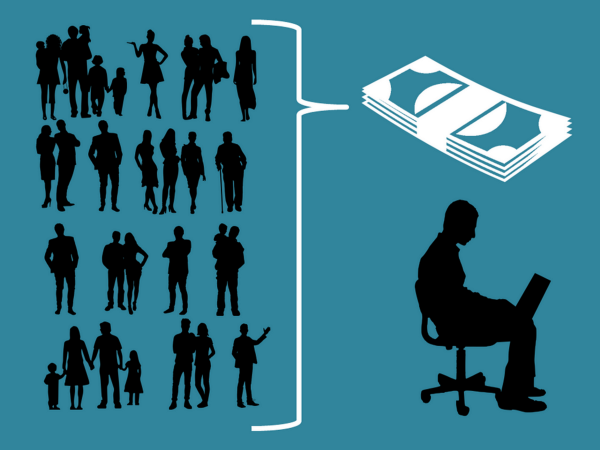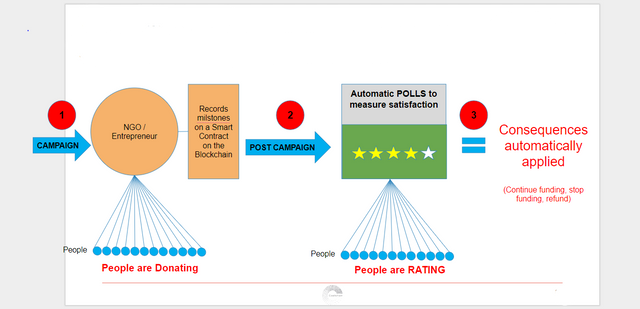 Blockchain to Ensure that Money is Well Spent
Blockchain to Ensure that Money is Well Spent
In our last article, we broached the topic of the tools needed to implement liquid democracy in the public sphere and add the possibility of holding representatives accountable for their actions.
The key factor in enforcing accountability is one that can easily find multiple applications in the civilian world as well. In fact, starting to apply automatically enforced accountability in the civilian world might well be the key to see it adopted by elected representatives a well.
Who could benefit from enforced accountability?
From investors to donators, everyone would benefit from being able to keep an eye on the funds they invested or donated. Especially if the automated accountability system enables recouping all or part of the funds in case the recipient proves to be unreliable.
So, who would benefit from offering to enable such a system in exchange for receiving funds. Anyone raising funds could use it. From an entrepreneur looking for investment to any organization that is raising funds from members or non-members, but from people who want to have assurances that the money they invest or donate is spent constructively.
Offering to receive the funds in stages, where each fund release is conditioned by the successful completion of a set of tasks defined in the smart-contract that is the cornerstone of the system demonstrates that the recipient believes in the project feasibility and intends to perform optimally.
Let’s imagine, for example, a caritative entity seeking to fund a project. In today’s world, donators give an amount deemed appropriate. After that, they basically hope that the institution will use that money for their stated purposed and that the bulk of their donation will indeed be applied to the stated goal of the institution.

Yet, in fact, aside from trusting third parties to check what percentage of their donations is devoted to the goal and what percentage is dedicated to finance the institution overheads, such as offices, salaries, travel expenses and the like, today’s donators have no way of checking that their hard-earned money will find its way to those in needs though the efficient management of the institution.
Even with the help of watchdogs offering some modicum of information regarding the percentage of donations devoted to overheads, donators have no recourse in case the institution simply waste the funds raised.
If only it there was a system keeping track of the way the money is being spent…
With blockchain technology and smart-contract, it is in fact possible. Not only possible but feasible and the tools to do so are about to be available…
Coalichain is developing a smart-contract that automates tracking and automatically enforces consequences, and is also providing a platform (App/web) for maximum ease of use by all and for all.
How would that work on a practical level?
Actually, it is quite easy. Let’s imagine an NGO devoted to providing shelter to displaced people. They are raising funds to finance the purchase and distribution of 50 000 solar tents to shelter Syrian displaced people in Syria and neighboring regions.
Presumably, they have an itemized budget, target areas and a timeline. These can be translated into milestones at pre-determined dates, or at time interval after reaching the donations threshold. Once milestones are established, a smart-contract can be created integrating these milestones and defining how to reward or sanction the NGO depending on the successful completion of the milestone goal.
It would work as follows:

In this fictional case, the NGO had successfully reached the first milestone of producing the 50 000 tents, and thus the funds needed for distribution have been automatically liberated, as they could successfully demonstrate that they met the pre-determined conditions.
The predetermined milestone stated that, upon receiving the funds, the NGO was to ship 20 000 tents to a specific location. So, upon receiving the funds, they diligently start booking the trucks and boats to ensure efficient transportation of those tents.
Unfortunately, war being unpredictable, the area where they were supposed to deliver the tents has now become an active war zone from where the displaced people are fleeing. They cannot possibly deliver the tents within the pre-determined time frame.
As they fail to reach the milestone, an automatic poll is triggered, and the donators are requested to vote and decide whether the NGO deserves to be sanctioned or not.
Luckily for the NGO, Coalichain’s app provides them with a platform where they can explain, with documentation if necessary, the reasons behind their failure to meet the milestone and what they intend to do to redress the situation.
As the donators are sensible people, they vote to grant a time extension and a redefinition of the delivery area.
though dramatic from a human point view, that is a happy story as far as supervising fund allocation is concerned.
However, in order to fully understand the system, let’s imagine another story. This time, an entrepreneur is seeking funding to develop an app. Let’s say, his app will enable users to measure their weight loss curve and respond with appropriate dietary and exercises recommendations. Our entrepreneur manages to crowdsource $1M.

In today’s system, like Kickstarter for example, once he has reached the funding goal, he immediately collects the entire sum (minus fees) and there is no guarantee that he will spend it in a wise and constructive manner.
With Coalichain system though, he will need to define milestones and money will be released gradually after each milestone is successfully concluded.
In this case, our entrepreneur milestones were roughly defined as follows, were the starting date is the successful conclusion of the crowdfunding campaign.
1. Within 40 days
a. Creation of a website
b. Hire additional developer
c. Complete at least of 30% of the code
Sum needed — $50 000
2. During the following 120 days
a. Complete the remainder of the code
b. Hire a UI/UX Designer
c. Implement the design
d. Debug
3. During the following 180 days
a. Deploy the app on Apple and Google store
b. Launch marketing campaign
c. Fix remaining bugs and add features according to users’ feedback
d. Gain 100k usersSum needed $750 000
The first milestone is fixed at 40 days from the crowdfunding campaign. When reached, our entrepreneur is introducing the new developer, showing the website he created and offering sample pages of the writer code as a proof of work completed with the initial $50 000 he received.
As most of the donators have no knowledge of coding whatsoever, nor any idea of the amount of work required to create a website, nor of link between a developer experience and the salary they should be paid, they would tend to be favorably impressed by the flashy website, the arcane looking lines of code and the nerdy look of the new developer. As such, they might reasonably consider the milestone completed and vote to free the funds marked for the second milestone.
However, being clueless about codding does not mean being totally clueless. As intelligent people aware of their lack of understanding of the intricacies of coding, the donators delegated their votes to those among them that do understand and trust them to evaluate the entrepreneur’s achievements.
The vote delegation system is briefly broached in the “What is Liquid Democracy?” part of our previous article. We will dedicate an entire article to that topic soon. For now, let’s simply consider that delegating votes is an option and see what it implies.

So, back to our entrepreneur’s milestone evaluation.
The delegates are reviewing the material submitted by the entrepreneur. As this is a field they do know quite well, they immediately notice that the website is a barely modified off-the-shelf template. That, in and of itself, is not necessarily bad, it might be a good way to save resources for coding and workforce, so it does not impress them either way.
However, when checking the hired developer qualifications, they immediately realize that the programming languages he has experience in might be good for old-fashioned website but is quite useless when it comes to app development. Glancing at the sample code is even worse. Not only is the language used not relevant for app development, it is also full of mistakes.
So, they vote that the milestone has not been successfully completed.
In such a case, the remaining amount, $950 000 is returned to the donators on a pro-rata base of their initial investment. They only lost a tiny fraction of their initial investment. As you can see, this system greatly reduces the inherent risks in investments in general.
These are just a few examples of how Coalichain can help ensure that raised funds will indeed be affected to the end goal in an efficient manner.
Coalichain’s customizable smart-contracts are designed to be adaptable and flexible. This way, it enables anyone unfamiliar with blockchain to easily create a smart-contract with gradual fund release upon verification that the preceding milestone has been reached.
Article Source - Hackernoon
Congratulations @coalichain! You received a personal award!
You can view your badges on your Steem Board and compare to others on the Steem Ranking
Vote for @Steemitboard as a witness to get one more award and increased upvotes!
Downvoting a post can decrease pending rewards and make it less visible. Common reasons:
Submit